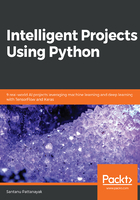
Deep Q-learning
In Q-learning, we generally work with a finite set of states and actions; this means that, tables suffice to hold the Q-values and rewards. However, in practical applications, the number of states and applicable actions are mostly infinite, and better Q-function approximators are needed to represent and learn the Q-functions. This is where deep neural networks come to the rescue, since they are universal function approximators. We can represent the Q-function with a neural network that takes the states and actions as input and provides the corresponding Q-values as output. Alternatively, we can train a neural network using only the states, and have the output as Q-values corresponding to all of the actions. Both of these scenarios are illustrated in the following diagram. Since the Q-values are rewards, we are dealing with regression in these networks:

In this book, we will use reinforcement learning to train a race car to drive by itself through deep Q-learning.